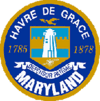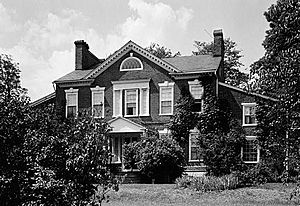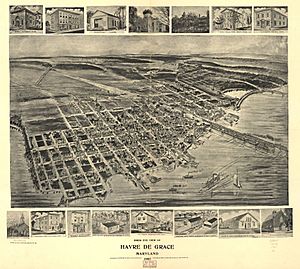Havre de Grace, Maryland facts for kids
Quick facts for kids
Havre de Grace, Maryland
|
|||
|---|---|---|---|
| City of Havre de Grace | |||
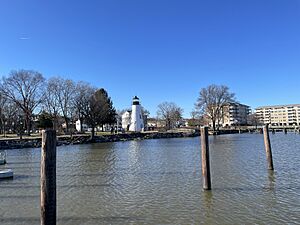
Havre de Grace waterfront at Concord Point Light
|
|||
|
|||
| Nickname(s):
"HdG"
|
|||

Location in Harford County and Maryland
|
|||
| Country | |||
| State | |||
| County | |||
| Incorporated | 1785 | ||
| Area | |||
| • Total | 6.32 sq mi (16.37 km2) | ||
| • Land | 5.89 sq mi (15.25 km2) | ||
| • Water | 0.43 sq mi (1.12 km2) 20.17% | ||
| Elevation | 56 ft (17 m) | ||
| Population
(2020)
|
|||
| • Total | 14,807 | ||
| • Density | 2,514.35/sq mi (970.83/km2) | ||
| Time zone | UTC−5 (Eastern) | ||
| • Summer (DST) | UTC−4 (Eastern) | ||
| ZIP Code |
21078
|
||
| Area code(s) | 410 | ||
| FIPS code | 24-37600 | ||
| GNIS feature ID | 0590437 | ||
| Website | www.havredegracemd.com | ||
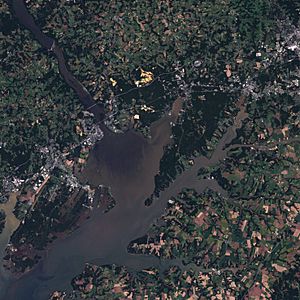
Havre de Grace, often called HdG, is a city in Harford County, Maryland, United States. It sits where the Susquehanna River meets the Chesapeake Bay. The city's name comes from Le Havre, a port city in France. Its full French name was Le Havre de Grâce, meaning "Harbor of Grace".
In 2020, about 14,807 people lived in Havre de Grace. In 2014, Smithsonian magazine named it one of the 20 best small U.S. towns to visit.
Contents
Discovering Havre de Grace's Past
How Havre de Grace Began
During the American Revolutionary War, a small village called Harmer's Town was visited by General Lafayette. He was a hero of the war. Lafayette said the area reminded him of the French seaport of Le Havre. This French city was originally named Le Havre-de-Grâce.
Inspired by Lafayette's words, the people of Harmer's Town officially named their town Havre de Grace in 1785. George Washington even stayed there in 1789 on his way to New York City for his first time as president. In 1789, Havre de Grace almost became the capital of the United States, missing it by just one vote!
Havre de Grace in the 1800s
On May 3, 1813, during the War of 1812, British forces attacked Havre de Grace. They were led by Sir George Cockburn. The British defeated the American soldiers and burned much of the village. An American soldier named Lieutenant John O'Neill bravely fought alone with a cannon. He was hurt and captured, but soon released.
To thank him, Havre de Grace made O'Neill and his family the official keepers of the Concord Point lighthouse. This lighthouse marks the start of the Susquehanna River.
Early jobs in Havre de Grace included catching oysters and crabs. Many fruit farms also grew nearby. Farmers sent their products to markets along the East Coast and up the river.
The town was the end point for the Susquehanna Canal. This canal helped boats get around tough parts of the lower Susquehanna River. It connected Havre de Grace to the Pennsylvania Canal in Wrightsville, Pennsylvania. The canal was built from 1836 to 1840. But after 1855, fewer boats used it because railroads could move goods faster. Today, you can visit the Lock Keeper's house and see parts of the old canal as a museum.
Havre de Grace was an important stop on the Underground Railroad in Maryland. This was a secret network that helped enslaved people find freedom. Before 1840, many enslaved people from areas near the Chesapeake Bay came to Havre de Grace. They often took a ferry across the Susquehanna River to safe places in Lancaster and Chester counties in Pennsylvania. When the ferry became too risky, they were guided upriver to cross at Columbia, Pennsylvania. Because Havre de Grace had different ways to cross the river, many people successfully reached the North.
In the 1800s, Havre de Grace became famous for duck hunting. Hunters would visit the town, stay in hotels, and hire local guides. Local artists became known for making beautiful decoys (fake ducks) for hunting. You can see great examples of these at the Decoy Museum in the city.
By the 1860s, many free African Americans lived in the town. They had their own businesses and found jobs related to shipping and railroads. During the American Civil War, Havre de Grace was one of seven places where the Army recruited African American men for the U.S. Colored Troops. Even though the area still had large farms with enslaved people, Havre de Grace was connected to northern businesses. This meant there were jobs for free African Americans, and many white residents supported the North.
In 1878, the town became a city and set up its own government. Soon after, Stephen J. Seneca opened a fruit-packing factory. He also had a tin can factory next to the Havre de Grace Waterfront. Seneca improved canning with his inventions, like "Can-soldering machines" in 1889 and 1891. By 1899, Seneca was a canned goods seller. The first railroad was built along St. Clair Street (now Pennington Ave.) to the river. This made Seneca's factory perfect for shipping by both water and rail. For many years, farmers brought their produce to the Seneca Factory. Stephen J. Seneca was also the Mayor of Havre de Grace from 1893 to 1894. He gave money and land to build the Methodist Church.
The old Seneca cannery building is now an antique shop. It is a good example of a brick factory building from the late 1800s.
Havre de Grace in the 1900s
More inventions followed the opening of the S. J. Seneca Cannery. These included the Baling-press (1901), the Cooker (1905), the Tomato-scalder (1905), an Improved Tomato-scalder (1917), the Can-opener (1917), and the Machine for peeling tomatoes (1918).
From 1912 to the 1950s, Havre de Grace was known as "The Graw." It was a popular stop for travelers going north or south. The Havre de Grace Racetrack was open from 1912 to 1950. In the late 1950s, the state closed the horse track. Its racing rights were bought by the larger Pimlico Race Course in Baltimore.
In 1949, the city stopped a Jehovah's Witnesses preacher from using a city park and arrested him. The case went to the U.S. Supreme Court. In 1951, the court decided that Jehovah's Witnesses had the right to speak in the park. This was protected by their constitutional right to freedom of religion.
In the 1980s, Havre de Grace started to change a lot. People were drawn to its special charm. Old buildings were fixed up and used for new things. Also, old farmland was used to build new houses and townhouses. It became a place for people to have "second homes" for vacations or to retire. Since the late 1900s, the city has grown with new homes, antique shops, and other stores.
Between 1990 and 2000, the average income in the city doubled. This was because wealthier people moved into new neighborhoods in and around the city. Many of these new residents travel to jobs elsewhere, or they are retired. New developments since the 1990s brought thousands of middle to upper-class people to the town. However, some working-class citizens who used to live in the city had to move because property values went up.
Havre de Grace in the 2000s
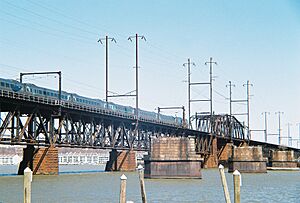
In September 2003, Hurricane Isabel caused flooding in the city. Water reached about two blocks into downtown and destroyed the waterfront walkway. It was rebuilt in 2004 with help from Americorps NCCC. Today, this walkway is a popular place for locals and tourists to walk. It goes from Tydings Park to the Maritime Museum and then to the Concord Point Lighthouse.
Havre de Grace has continued to grow in the 2000s by adding more land. New housing is being built at a steady pace. The city has also been affected by the BRAC activities of the Department of Defense. The Department of Defense moved jobs and people from other bases to the Aberdeen Proving Ground (APG), which is only a few miles away. This has increased the need for homes and services in Havre de Grace.
Geography and Climate
Havre de Grace is located at 39°32′54″N 76°5′51″W / 39.54833°N 76.09750°W. This is where the Susquehanna River meets the Chesapeake Bay.
The U.S. Census Bureau says the city covers about 6.89 square miles (17.85 square kilometers). About 5.50 square miles (14.24 square kilometers) is land, and 1.39 square miles (3.60 square kilometers) is water.
Havre de Grace is about 40 miles (64 km) northeast of Baltimore. It is also about 40 miles (64 km) west of Wilmington, Delaware. Philadelphia is about 68 miles (109 km) northeast, and Washington, D.C. is about 75 miles (121 km) northeast. New York City is about 154 miles (248 km) southwest.
What is the Climate Like?
The weather in Havre de Grace has hot, humid summers. Winters are usually mild to cool. This type of weather is called a humid subtropical climate.
Population and People
| Historical population | |||
|---|---|---|---|
| Census | Pop. | %± | |
| 1850 | 1,335 | — | |
| 1860 | 1,963 | 47.0% | |
| 1870 | 2,281 | 16.2% | |
| 1880 | 2,816 | 23.5% | |
| 1890 | 3,244 | 15.2% | |
| 1900 | 3,423 | 5.5% | |
| 1910 | 4,212 | 23.0% | |
| 1920 | 4,377 | 3.9% | |
| 1930 | 3,985 | −9.0% | |
| 1940 | 4,967 | 24.6% | |
| 1950 | 7,809 | 57.2% | |
| 1960 | 8,510 | 9.0% | |
| 1970 | 9,791 | 15.1% | |
| 1980 | 8,763 | −10.5% | |
| 1990 | 8,952 | 2.2% | |
| 2000 | 11,331 | 26.6% | |
| 2010 | 12,952 | 14.3% | |
| 2020 | 14,807 | 14.3% | |
| U.S. Decennial Census | |||
How Many People Live Here?
In 2010, there were 12,952 people living in Havre de Grace. There were 5,258 households and 3,333 families. The city had about 2,355 people per square mile (909 per square kilometer).
Most people in the city (75.7%) were White. About 16.8% were African American, and 2.4% were Asian. About 4.7% of the population was Hispanic or Latino.
The average age in the city was 41.9 years old. About 21.9% of residents were under 18. About 13.9% were 65 years or older. The population was 48.4% male and 51.6% female.
Getting Around Havre de Grace
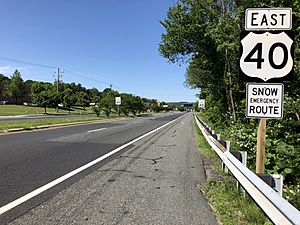
Roads and Highways
Most people travel to and from Havre de Grace by road. The main highway is U.S. Route 40. This road goes east to Wilmington and west to Baltimore. U.S. Route 40 also includes the Thomas J. Hatem Memorial Bridge. This road bridge crosses the Susquehanna River right from the city. Many travelers also reach Havre de Grace using Maryland Route 155, which connects to Interstate 95. Other state roads in the city include Route 7, Route 490, and Route 763.
Railroads
Two main railroad lines go through Havre de Grace. More than 80 passenger trains each day use Amtrak's busy Northeast Corridor. They speed through the city at 90 miles per hour (145 km/h) on a raised track. This track connects to the Amtrak Susquehanna River Bridge. The bridge was built between 1904 and 1906. It replaced an older wooden bridge from 1866. You can still see parts of the old bridge from the city's David R. Craig Park.
The Philadelphia Subdivision of CSX Transportation also carries many freight trains. This line crosses the river on the CSX Susquehanna River Bridge. This bridge was rebuilt between 1907 and 1910. It is about 1 mile (1.6 km) upstream from the Amtrak bridge.
Fun Things to See and Do
Havre de Grace is a popular place for fun and tourism. This is because it is located at the top of the Chesapeake Bay and where the Susquehanna River flows into it. There are places for boats and other services along the shore. The city's yacht basin and park host many events each year.
The rebuilt walkway and boardwalk along the shore is a favorite spot. It goes from the Concord Point Lighthouse to the yacht basin. Locals and tourists love to walk there and enjoy views of the bay.
In 1987, the main business area was added to the National Register of Historic Places. This means it is recognized for its special buildings and history. Several museums help tell the story of the city's past and present on the water. These include the Decoy Museum, the Havre de Grace Maritime Museum, Concord Point Lighthouse, the Lockhouse Museum, and the Black Eyed Susan paddle steamer. Havre de Grace also has a renovated seaplane port. There is also the Washington Street Books Entertainment Museum.
The city has four public schools and Harford Memorial Hospital. This was the first hospital built in Harford County. A project that is still raising money is the restoration of the Havre de Grace Colored School Museum and Cultural Center.
Famous People From Havre de Grace
Many notable people have connections to Havre de Grace:
- Harriet Baker (1829–1913), a religious speaker.
- Charles Bradley (born 1959), played basketball for the Boston Celtics and Seattle SuperSonics.
- David R. Craig (born 1949), served as the Harford County Executive.
- Nella Dodds (born 1950), a singer and actress.
- David Hasselhoff (born 1952), a famous actor and musician.
- Brionna Jones (born 1995), a WNBA basketball player.
- Ultra Naté (born 1968), a house music singer and songwriter.
- Immanuel Quickley (born 1999), a professional basketball player for the Toronto Raptors.
- Bill Ripken (born 1964), played baseball for the Baltimore Orioles and other teams.
- Cal Ripken Jr. (born 1960), a Baseball Hall of Famer who played for the Orioles.
- William Sleator (1945–2011), an author of young adult science-fiction novels.
- Millard Tydings (1890–1961), a U.S. Senator.
Local Media
- The Aegis, a newspaper based in Bel Air.
- The Sun, a newspaper from Baltimore.
- WHGM - A classic hits radio station in Havre de Grace.
- WXCY-FM - A country music radio station in Havre de Grace.
Sister Cities
Havre de Grace has a Sister city relationship with Mumbles, ![]() Wales.
Wales.
Havre de Grace also has a Sister City relationship with ![]() Sillamäe, Ida-Viru County, Estonia.
Sillamäe, Ida-Viru County, Estonia.
See also
 In Spanish: Havre de Grace (Maryland) para niños
In Spanish: Havre de Grace (Maryland) para niños



